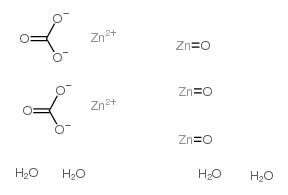3486-35-9
| Name | Zinc carbonate |
|---|---|
| Synonyms |
Zinkcarbonat
carbonuredezinc EINECS 222-477-6 zincmonocarbonate naturalsmithsonite zincspar smithsonite MFCD00151660 |
| Density | 4,398 g/cm3 |
|---|---|
| Boiling Point | 333.6ºC at 760 mmHg |
| Molecular Formula | C2H8O13Zn5 |
| Molecular Weight | 566.97700 |
| Flash Point | 169.8ºC |
| Exact Mass | 559.64200 |
| PSA | 214.51000 |
| Stability | Stable. Incompatible with acids. |
Synonym:Zinc carbonate (1:1); Zinc Monocarbonate; Carbonic acid, zinc salt Section 2 - COMPOSITION, INFORMATION ON INGREDIENTS
Risk Phrases: None Listed. Section 3 - HAZARDS IDENTIFICATION EMERGENCY OVERVIEW
The toxicological properties of this material have not been fully investigated. Potential Health Effects Eye: May cause eye irritation. Skin: May cause skin irritation. Ingestion: May cause gastrointestinal irritation with nausea, vomiting and diarrhea. Inhalation: May cause respiratory tract irritation. Chronic: No information found. Section 4 - FIRST AID MEASURES Eyes: Flush eyes with plenty of water for at least 15 minutes, occasionally lifting the upper and lower eyelids. Get medical aid. Skin: Get medical aid if irritation develops or persists. Flush skin with plenty of soap and water. Ingestion: If victim is conscious and alert, give 2-4 cupfuls of milk or water. Never give anything by mouth to an unconscious person. Get medical aid if irritation or symptoms occur. Inhalation: Remove from exposure and move to fresh air immediately. If not breathing, give artificial respiration. If breathing is difficult, give oxygen. Get medical aid if cough or other symptoms appear. Notes to Physician: Section 5 - FIRE FIGHTING MEASURES General Information: As in any fire, wear a self-contained breathing apparatus in pressure-demand, MSHA/NIOSH (approved or equivalent), and full protective gear. During a fire, irritating and highly toxic gases may be generated by thermal decomposition or combustion. Extinguishing Media: Use extinguishing media most appropriate for the surrounding fire. Section 6 - ACCIDENTAL RELEASE MEASURES General Information: Use proper personal protective equipment as indicated in Section 8. Spills/Leaks: Sweep up or absorb material, then place into a suitable clean, dry, closed container for disposal. Section 7 - HANDLING and STORAGE Handling: Wash thoroughly after handling. Remove contaminated clothing and wash before reuse. Use with adequate ventilation. Avoid contact with skin and eyes. Avoid ingestion and inhalation. Storage: Store in a cool, dry place. Keep containers tightly closed. Section 8 - EXPOSURE CONTROLS, PERSONAL PROTECTION Engineering Controls: Use adequate ventilation to keep airborne concentrations low. Exposure Limits CAS# 3486-35-9: Personal Protective Equipment Eyes: Wear appropriate protective eyeglasses or chemical safety goggles as described by OSHA's eye and face protection regulations in 29 CFR 1910.133 or European Standard EN166. Skin: Wear appropriate protective gloves to prevent skin exposure. Clothing: Wear appropriate protective clothing to prevent skin exposure. Respirators: A respiratory protection program that meets OSHA's 29 CFR 1910.134 and ANSI Z88.2 requirements or European Standard EN 149 must be followed whenever workplace conditions warrant respirator use. Section 9 - PHYSICAL AND CHEMICAL PROPERTIES Physical State: Solid Color: white Odor: odorless pH: Not applicable. Vapor Pressure: Not applicable. Viscosity: Not applicable. Boiling Point: Not applicable. Freezing/Melting Point: Decomposes. Autoignition Temperature: Not applicable. Flash Point: Not applicable. Explosion Limits, lower: Not available. Explosion Limits, upper: Not available. Decomposition Temperature: 300 deg C Solubility in water: Insoluble in water. Specific Gravity/Density: 4.398 Molecular Formula: ZnCO3 Molecular Weight: 125.3782 Section 10 - STABILITY AND REACTIVITY Chemical Stability: Stable under normal temperatures and pressures. Decomposed by acids with effervescence, evolution of carbon dioxide. Conditions to Avoid: Dust generation. Incompatibilities with Other Materials: Strong acids. Hazardous Decomposition Products: Carbon dioxide, zinc oxides. Hazardous Polymerization: Will not occur. Section 11 - TOXICOLOGICAL INFORMATION RTECS#: CAS# 3486-35-9: FG3375000 LD50/LC50: Not available. Carcinogenicity: Zinc carbonate - Not listed by ACGIH, IARC, or NTP. Other: See actual entry in RTECS for complete information. Section 12 - ECOLOGICAL INFORMATION Section 13 - DISPOSAL CONSIDERATIONS Dispose of in a manner consistent with federal, state, and local regulations. Section 14 - TRANSPORT INFORMATION IATA Not regulated as a hazardous material. IMO Not regulated as a hazardous material. RID/ADR Not regulated as a hazardous material. USA RQ: CAS# 3486-35-9: 1000 lb final RQ; 454 kg final RQ Section 15 - REGULATORY INFORMATION European/International Regulations European Labeling in Accordance with EC Directives Hazard Symbols: Not available. Risk Phrases: Safety Phrases: S 24/25 Avoid contact with skin and eyes. WGK (Water Danger/Protection) CAS# 3486-35-9: 0 Canada CAS# 3486-35-9 is listed on Canada's DSL List. CAS# 3486-35-9 is not listed on Canada's Ingredient Disclosure List. US FEDERAL TSCA CAS# 3486-35-9 is listed on the TSCA inventory. SECTION 16 - ADDITIONAL INFORMATION N/A |
| Safety Phrases | S22-S24/25 |
|---|---|
| WGK Germany | 1 |
| Hazard Class | 9.2 |
| HS Code | 2836999000 |
| HS Code | 2836999000 |
|---|

